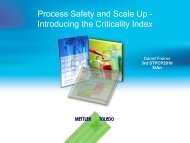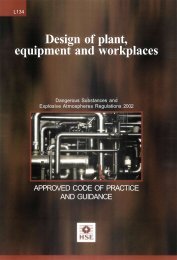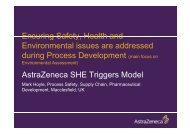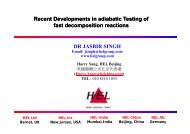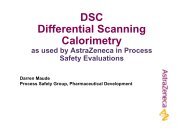Designing and operating safe chemical reaction processes HSG143
Designing and operating safe chemical reaction processes HSG143
Designing and operating safe chemical reaction processes HSG143
You also want an ePaper? Increase the reach of your titles
YUMPU automatically turns print PDFs into web optimized ePapers that Google loves.
Health <strong>and</strong> SafetyExecutive(f) the time limits for which the permit is valid; <strong>and</strong>(g) the person in direct control of the work.Further advice on PTWs is available in a HSE leaflet. 48197 You will also need to check the plant is in a <strong>safe</strong> state before bringing it backinto operation. This may mean carrying out various checks or tests, eg pressuretesting.Routine checks/<strong>safe</strong>ty audits198 Active monitoring, before things go wrong, involves regular inspection <strong>and</strong>checking to ensure that the systems <strong>and</strong> procedures you have developed areactually being implemented <strong>and</strong> followed.199 Audits, by your own staff or outsiders, complement monitoring activities bylooking to see if your policy, organisation <strong>and</strong> systems are actually achieving thedesired objectives.200 For example, are your operators aware of the basis of <strong>safe</strong>ty, <strong>and</strong> that thevent installed on the reactor is not there to protect against an exothermic runaway?Why have the operators changed the sequence of valve operations to that stated inthe <strong>safe</strong> <strong>operating</strong> procedures? Is it because they repeatedly have to walk up <strong>and</strong>down flights of stairs to comply with the correct procedure?Emergency procedures201 Initiating emergency procedures at the earliest stage of an incident cansignificantly reduce the impact of an incident on people <strong>and</strong> premises. You willneed, therefore, a written procedure for dealing with any reasonably foreseeableincident, for example fires, spills or leaks. It should cover:(a) raising the alarm;(b) calling the emergency services;(c) evacuating the area <strong>and</strong> providing <strong>safe</strong> havens; <strong>and</strong>(d) tackling the fire or controlling the spill or leak (when it is <strong>safe</strong> to do so).202 If you are a top-tier COMAH site (see Appendix 1), guidance is available onthe details which should be present in your on-site emergency plan. 49 This may alsohelp even if the COMAH Regulations 8 do not apply at your site.203 You need to consider the range of possible events to take into account thefollowing:(a) the nature <strong>and</strong> quantities of the materials involved;(b) the location of the process <strong>and</strong> its design; <strong>and</strong>(c) the people <strong>and</strong> environment, both on-site <strong>and</strong> off-site that may be affected.204 When the fire brigade arrive they will assume responsibility for firefighting<strong>and</strong> rescue operations. They may, at the discretion of the fire brigade incident<strong>Designing</strong> <strong>and</strong> <strong>operating</strong> <strong>safe</strong> <strong>chemical</strong> <strong>reaction</strong> <strong>processes</strong> Page 38 of 64





